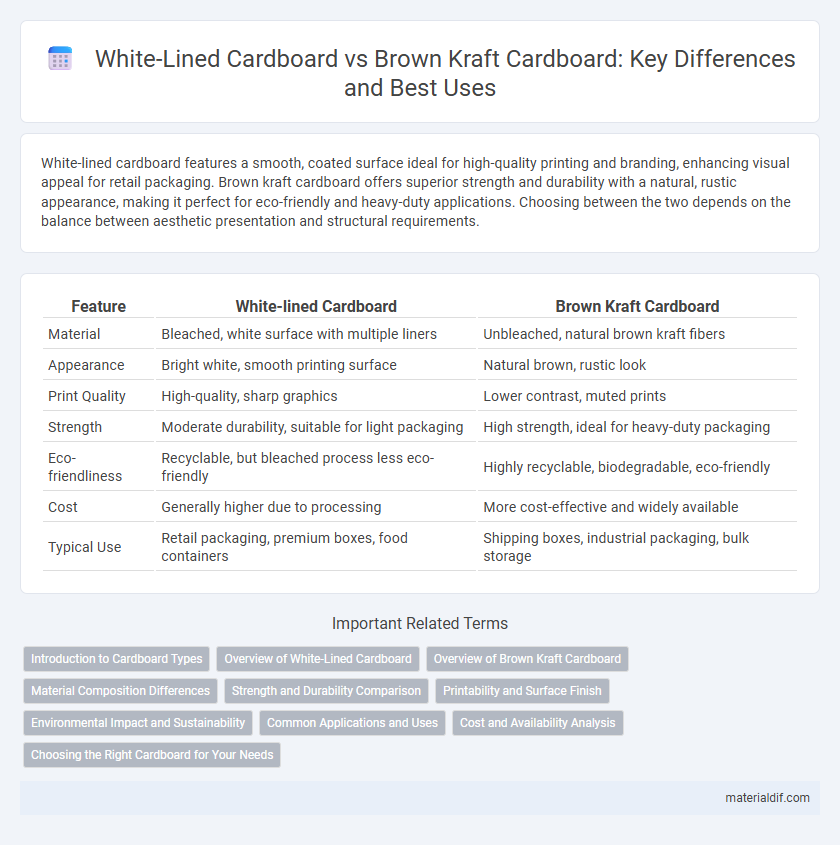White-lined cardboard features a smooth, coated surface ideal for high-quality printing and branding, enhancing visual appeal for retail packaging. Brown kraft cardboard offers superior strength and durability with a natural, rustic appearance, making it perfect for eco-friendly and heavy-duty applications. Choosing between the two depends on the balance between aesthetic presentation and structural requirements.
Table of Comparison
| Feature | White-lined Cardboard | Brown Kraft Cardboard |
|---|---|---|
| Material | Bleached, white surface with multiple liners | Unbleached, natural brown kraft fibers |
| Appearance | Bright white, smooth printing surface | Natural brown, rustic look |
| Print Quality | High-quality, sharp graphics | Lower contrast, muted prints |
| Strength | Moderate durability, suitable for light packaging | High strength, ideal for heavy-duty packaging |
| Eco-friendliness | Recyclable, but bleached process less eco-friendly | Highly recyclable, biodegradable, eco-friendly |
| Cost | Generally higher due to processing | More cost-effective and widely available |
| Typical Use | Retail packaging, premium boxes, food containers | Shipping boxes, industrial packaging, bulk storage |
Introduction to Cardboard Types
White-lined cardboard features a smooth, white surface often used for high-quality printing and packaging, enhancing product presentation and brand visibility. Brown kraft cardboard is known for its natural, durable fibers, providing strength and eco-friendly qualities ideal for shipping and heavy-duty applications. Both types serve different purposes based on visual appeal and structural requirements in packaging industries.
Overview of White-Lined Cardboard
White-lined cardboard features a smooth, bright white surface ideal for high-quality printing and product presentation, commonly used in packaging for cosmetics, food, and pharmaceuticals. Its multi-layer construction typically includes a white top layer for enhanced visual appeal and several brown or recycled fiber layers underneath for strength. This type of cardboard offers a balance of durability and aesthetics, making it a preferred choice for brands seeking both functionality and attractive packaging.
Overview of Brown Kraft Cardboard
Brown kraft cardboard is known for its durability and high tear resistance due to its natural wood pulp fibers and minimal processing. Unlike white-lined cardboard, which has a smooth, coated surface for printing, brown kraft cardboard maintains a rough, uncolored texture ideal for eco-friendly packaging and industrial use. Its strength and recyclability make it a preferred choice for heavy-duty shipping boxes and sustainable packaging solutions.
Material Composition Differences
White-lined cardboard features a top layer of white coated paper bonded to layers of recycled fibers, providing a smooth, printable surface ideal for retail packaging and branding. Brown kraft cardboard is made from unbleached virgin wood fibers, resulting in a sturdy, eco-friendly material valued for its strength and natural brown tone suited for industrial and shipping uses. The white-lined variant emphasizes aesthetic appeal and print clarity, while brown kraft prioritizes durability and environmental sustainability through its material composition.
Strength and Durability Comparison
White-lined cardboard typically features a smoother surface and a coated white outer layer, which enhances print quality but may slightly reduce its overall strength compared to brown kraft cardboard. Brown kraft cardboard is renowned for its superior strength and durability, thanks to its unbleached, thicker fibers that provide better resistance to tearing and crushing. For packaging applications requiring robust protection and longevity, brown kraft cardboard generally outperforms white-lined cardboard in structural integrity.
Printability and Surface Finish
White-lined cardboard offers superior printability compared to brown kraft cardboard due to its smooth, coated surface that enhances ink adhesion and color vibrancy. The glossy finish of white-lined cardboard provides a high-quality visual appeal, making it ideal for packaging that requires detailed graphics and branding. In contrast, brown kraft cardboard has a more textured, uncoated surface, which limits print clarity but offers a natural and rustic aesthetic preferred for eco-friendly packaging.
Environmental Impact and Sustainability
White-lined cardboard typically involves bleaching processes that release chemicals, contributing to higher environmental pollution compared to Brown kraft cardboard, which uses unbleached fibers and natural materials. Brown kraft cardboard is often more sustainable due to its easier recyclability and biodegradability, reducing landfill waste and lowering carbon emissions throughout its lifecycle. Industrial facilities prefer Brown kraft cardboard for eco-friendly packaging solutions that support circular economy principles.
Common Applications and Uses
White-lined cardboard is commonly used in packaging for retail products, food containers, and consumer goods due to its smooth printable surface and clean appearance. Brown kraft cardboard is often chosen for shipping boxes, industrial packaging, and eco-friendly products because of its durability, natural look, and recyclability. Both materials are selected based on the balance between aesthetic needs and structural strength required for their specific applications.
Cost and Availability Analysis
White-lined cardboard typically costs more than brown kraft cardboard due to its additional processing and higher-quality outer layers designed for improved printability and aesthetics. Brown kraft cardboard is widely available and favored for cost-effective packaging solutions, with lower production expenses since it uses unbleached, recycled fibers. Both materials are readily accessible in global markets, but brown kraft cardboard offers superior availability for bulk orders and budget-conscious projects.
Choosing the Right Cardboard for Your Needs
White-lined cardboard offers a smooth, printable surface ideal for branding and retail packaging, while brown kraft cardboard provides superior strength and eco-friendly qualities suited for shipping and heavy-duty applications. Selecting the right cardboard depends on the intended use, with white-lined cardboard preferred for presentation and brown kraft for durability and recyclability. Consider factors such as environmental impact, printability, and structural requirements to ensure optimal performance in your packaging solutions.
White-lined cardboard vs Brown kraft cardboard Infographic

 materialdif.com
materialdif.com